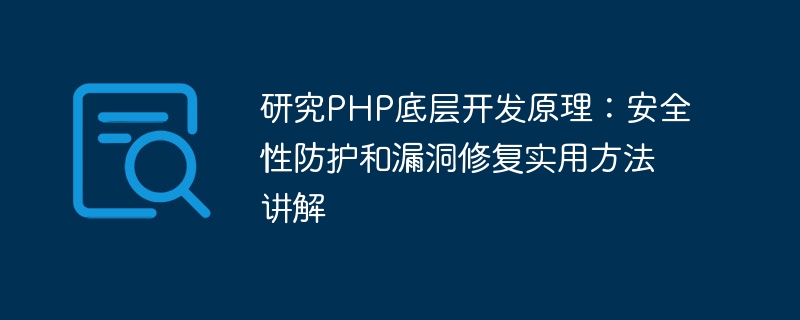
Study on the underlying development principles of PHP: Explanation of practical methods for security protection and vulnerability repair
In web development, PHP is a widely used server-side scripting language. However, with the increasing number of network attacks, security issues have become an important issue that developers must pay attention to. This article will introduce practical methods of security protection and vulnerability repair for PHP underlying development, and explain it through code examples.
1. Security Protection
- Data filtering and verification: The data input by the user must be filtered and verified to prevent malicious input from causing damage to the system. PHP provides a series of filtering and verification functions, such as filter_var() and preg_match(). The following is a simple example to verify whether the email address entered by the user is legitimate:
$email = $_POST['email'];
if (filter_var($email, FILTER_VALIDATE_EMAIL)) {
// 合法的邮箱地址
} else {
// 非法的邮箱地址
}Copy after login
- Prevent SQL injection: SQL injection is a common web security vulnerability that allows attackers to insert errors in user input Insert SQL code to achieve unauthorized access to the database. To prevent SQL injection attacks, parameterized queries or prepared statements can be used. The following is an example of using prepared statements:
$stmt = $pdo->prepare('SELECT * FROM users WHERE username = :username');
$stmt->execute(['username' => $username]);
$result = $stmt->fetchAll();Copy after login
- Prevent cross-site scripting attacks (XSS): XSS is an attack technique in which attackers insert malicious script code into web pages. Thereby stealing user information or tampering with web content. In order to prevent XSS attacks, you can use the htmlspecialchars() function to escape the output content. The following is an example of using the htmlspecialchars() function:
echo htmlspecialchars($_GET['name']);
Copy after login
2. Vulnerability fixes
- Regularly update the PHP version: The PHP community will regularly release new versions, and the fixes have been known security vulnerabilities. In order to maintain system security, developers should promptly upgrade the PHP version.
- Use a secure password storage solution: Passwords are an important part of user data, and a secure encryption solution should be used when storing passwords. PHP provides password hash functions password_hash() and password_verify(), which can be used to encrypt and verify passwords. Here is an example of using password_hash() and password_verify():
// 存储密码
$password = $_POST['password'];
$hashed_password = password_hash($password, PASSWORD_DEFAULT);
// 验证密码
$password = $_POST['password'];
$hashed_password = ''; // 从数据库中获取存储的密码
if (password_verify($password, $hashed_password)) {
// 密码验证通过
} else {
// 密码验证失败
}Copy after login
- Use a secure file upload scheme: File upload is a common feature in web development, but it can also be easily abused. In order to prevent malicious file uploads, the following methods can be used for security processing:
- Only allow uploading of allowed file types.
- Scan uploaded files for viruses.
- Randomly generate file names and storage paths to prevent malicious files from overwriting existing files.
$allowed_types = ['image/jpeg', 'image/png'];
$upload_dir = 'uploads/';
$file = $_FILES['file'];
if (in_array($file['type'], $allowed_types) && $file['error'] == 0) {
$file_name = uniqid() . '-' . $file['name'];
move_uploaded_file($file['tmp_name'], $upload_dir . $file_name);
}Copy after login
Summary:
This article introduces the security protection and vulnerability repair methods of PHP underlying development, and explains it through code examples. In actual development, developers should always pay attention to the security of the system and take appropriate security protection measures to prevent malicious attacks from causing damage to the system.
The above is the detailed content of Study the underlying development principles of PHP: Explanation of practical methods for security protection and vulnerability repair. For more information, please follow other related articles on the PHP Chinese website!






